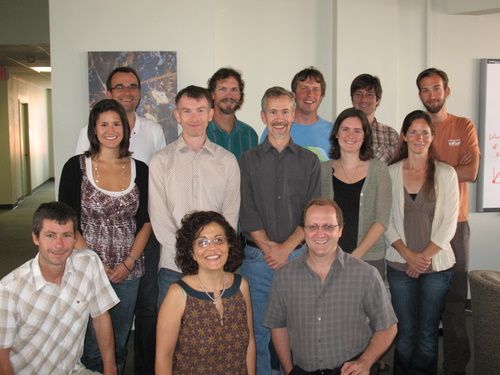NCEAS Working Groups
Biodiversity and the functioning of ecosystems: Translating results from model experiments into functional reality
Project Description
We are currently in the midst of one of the greatest waves of species extinction that has ever occurred on Earth. But even as rates of species loss are approaching those of prior mass extinctions, we know little about the different roles that species play in ecosystems, and we have almost no idea how the well-being of our own species is linked to the great variety of life that inhabits our planet.
The goal of our working group is to improve our understanding of the consequences of species extinction for humanity. We will summarize the results of more than two decades of ecological experiments that have examined how the diversity of bacteria, fungi, plants and animals influence biological processes that are essential to the existence of life. Using these data, we will:
1) Develop statistical models that estimate how many species must be conserved to maintain essential biological processes in natural ecosystems
2) Quantify trade-offs in how biodiversity impacts different biological processes so that we can make informed decisions about how to maximize the ‘multi-functionality’ of diverse systems
3) Assess how biodiversity affects selected services that natural ecosystems provide to society, such as plant uptake of greenhouse gases like CO2 from the atmosphere
Our work is timely, as the United Nations General Assembly has named 2010 as the International Year of Biodiversity. Our results will help aid international efforts to conserve and manage species and their natural habitats in a period of unprecedented environmental change.

Principal Investigator(s)
Bradley J. Cardinale, J. Emmett Duffy, Dave U. Hooper
Project Dates
Start: August 9, 2010
End: October 14, 2011
completed
Participants
- Elizabeth C. Adair
- University of California, Santa Barbara
- Patricia Balvanera
- Universidad Nacional Autónoma de México (UNAM), Morelia
- Jarrett E. Byrnes
- University of California, Santa Barbara
- Bradley J. Cardinale
- University of Michigan
- Laura E. Dee
- University of California, Santa Barbara
- J. Emmett Duffy
- College of William and Mary
- Lars Gamfeldt
- Swedish University of Agricultural Sciences
- Andrew Gonzalez
- McGill University
- Michael Goulden
- University of California, Irvine
- John N. Griffin
- University of Florida
- Andrew Hector
- University of Zurich
- Dave U. Hooper
- Western Washington University
- Bruce A. Hungate
- Northern Arizona University
- Forest Isbell
- University of Minnesota
- Jonathan S. Lefcheck
- Virginia Institute of Marine Science
- Kristin L. Matulich
- University of California, Irvine
- Christian Messier
- Université du Québec, Montreal
- Mary I. O'Connor
- University of California, Santa Barbara
- Alain Paquette
- Université du Québec, Montreal
- Daniel Piotto
- Yale University
Products
-
Journal Article / 2018
Ecosystem context illuminates conflicting roles of plant diversity in carbon storage
-
Journal Article / 2013
Linking biodiversity and ecosystem services: Current uncertainties and the necessary next steps
-
Journal Article / 2014
Investigating the relationship between biodiversity and ecosystem multifunctionality: Challenges and solutions
-
Presentations / 2011
Biodiversity and ecosystem functioning
-
Presentations / 2011
Biodiversity and ecosystem functioning
-
Presentations / 2011
Biodiversity and the functioning of ecosystems: The evolution of, and vision for, a paradigm
-
Journal Article / 2011
The functional role of producer diversity in ecosystems
-
Presentations / 2012
Biodiversity and ecosystem functioning
-
Presentations / 2012
Biodiversity, extinction, and their impacts on humanity
-
Journal Article / 2012
Biodiversity loss and its impact on humanity
-
Presentations / 2012
What is biodiversity's role in providing ecosystem goods and services? A data synthesis
-
Presentations / 2012
Will species extinction alter the function of Earth's freshwater ecosystems?
-
Journal Article / 2013
Biodiversity simultaneously enhances the production and stability of community biomass, but the effects are independent
-
Presentations / 2011
The role of biodiversity in ecosystem functioning: Translating results from model experiments into functional reality
-
Presentations / 2011
The role of biodiversity in ecosystem functioning: Translating results from model experiments into functional reality
-
Presentations / 2011
Marine species richness and ecosystem functioning - A meta-analysis
-
Journal Article / 2015
Marine biodiversity and ecosystem functioning: What's known and what's next?
-
Presentations / 2012
Biodiversity loss is real and it matters
-
Presentations / 2012
Biodiversity science for global environmental change
-
Data Set / 2013
Data set for Griffen et al. 2013 Effects of predator richness on prey Suppression: A meta-analysis
-
Journal Article / 2013
Effects of predator richness on prey suppression: A meta-analysis
-
Journal Article / 2014
Species richness and the temporal stability of biomass production: An analysis of recent biodiversity experiments
-
Presentations / 2011
Do the effects of species richness on ecosystem function rival other forms of environmental change?
-
Journal Article / 2012
A global synthesis reveals biodiversity loss as a major driver of ecosystem change
-
Data Set / 2012
Data and analyses for Hooper et al. (2012) Nature, "A global synthesis reveals biodiversity loss as a major driver of ecosystem change", DOI: 10.1038/nature11118
-
Presentations / 2012
Biodiversity effects on provision of multiple ecosystem functions in marine systems: A meta-analysis
-
Journal Article / 2015
Biodiversity enhances ecosystem multifunctionality across trophic levels and habitats
-
Journal Article / in press
A general biodiversity-function relationship is mediated by trophic level
